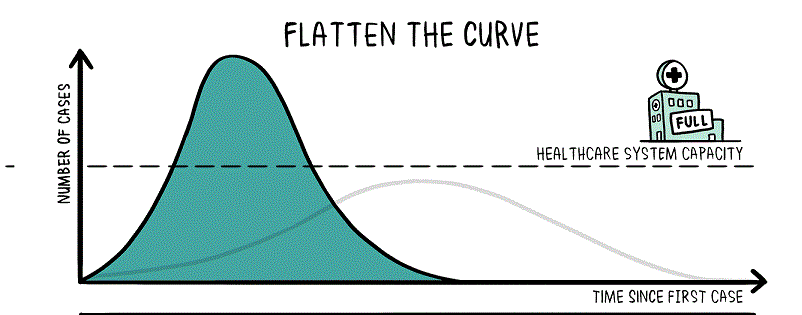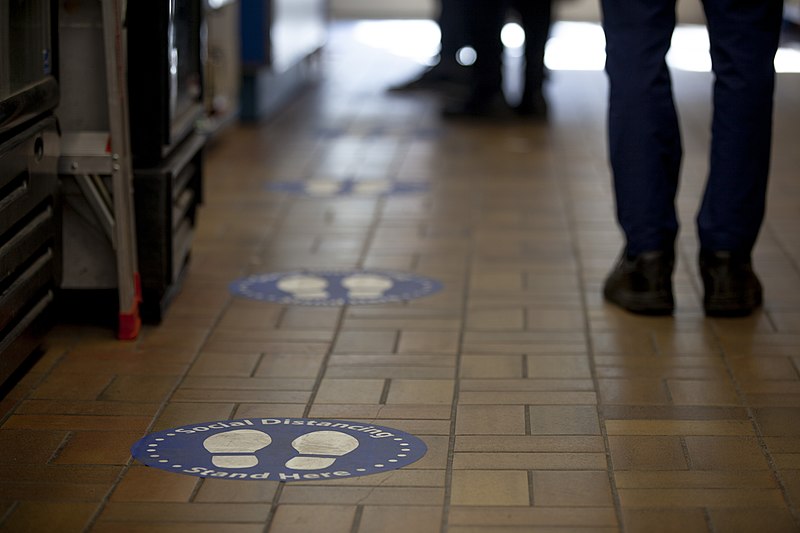The novel Coronavirus is here to stay. We have to live with it whether we like it or not. But in subsequent years it might be much more benign. Next season Coronavirus may return again. But it may not grab attention as most of us would have developed antibodies against it. Also, hopefully vaccine against Coronavirus would be in place by then. So, in subsequent years, it might be like any other flu virus. That said, we are still not sure for how long would we gain immunity against the virus. In other words, how long would the antibodies remain in our blood? Secondly, what if the virus mutates and some variant strain comes over. So, we are still in assumption phase till large and long term clinical studies are in pipeline1 and prove otherwise. I am writing this blog to reiterate that in the time of Coronavirus why social distancing is important, by taking two scenarios-with and without social distancing.
Eventually everyone is going to contract the infection. The only difference would be that those with strong immune system will have a narrow escape. They will fall ill, get recovered within 10-15 days and won’t even remember it few months from now. But those with weak immune system would suffer. They and their family members would remember it for lifetime.
What if we do not follow social distancing?
What if we do not go for any measures now like social distancing or lockdown to curb the Coronavirus? Indian population is going to witness an ebullition in the number of cases in the coming weeks. It’s not surprising because that’s the nature of this virus, it has a cascading effect. It’s like a fire in a forest that spreads with the blink of an eye. We have examples of China, Italy and U.S. in front of us. Now, out of those millions, those with good immune system, will experience flu like symptoms and will recover within 10 to 15 days. Only those with compromised immunity would suffer casualties. The positive side to this scenario is that the spread of the infection widely would lead to herd immunity as more and more people (herd) develop immunity, the virus would become powerless across masses. That means, a large number of people in the community will be immune from the virus and they (herd) will protect even those who are yet not immune. But the question is at what cost? According to an expert analysis, nearly 50 % of the population needs to be infected and recovered to achieve herd immunity. In India, that percentage would amount to nearly 700 million people. This would reduce the disease outbreak because most of the population would be then resistant to infection. However, this catastrophic scenario would not only lead to nationwide casualties but also engulf our healthcare system. Relying on herd immunity (especially in the absence of vaccine) to combat such a pandemic could be disastrous or rather I would say insensitive and unethical.
Till the vaccine is not in place (Clinical trials have begun in many countries to develop vaccine against Coronavirus however it seems unlikely to hit the market for some 12 to 18 months from now)2 and we have not developed immunity against the Coronavirus, least we can do is to break the chain of transmission by social distancing, according to recent study by Imperial College COVID-19 Response Team3.
Why social distancing is important?
The reason why social distancing is important at this point of time is to give some breathing space to our healthcare system so that we do not overwhelm it by cascading the number of cases. Those who have recovered after contracting the virus, virus are powerless in their system; it cannot multiply any longer there. And those who are dying from Coronavirus, virus is at a big loss because it is losing its host. Now the virus is in search of a new host. Virus in itself is powerless. It is not a living organism. It is just a protein molecule covered by a fat layer. It needs a host body to replicate. When we will practice social distancing, we will attenuate the virus by not giving it enough hosts to spread. So social distancing means those who are not infected with the virus should distance themselves physically from the outside world completely. Moreover, keeping the positive and suspected Coronavirus cases in isolation and distancing the elderly and the vulnerable population from outside world. By doing this, our goal is to slow down the replication of the virus i.e. lessen the number of cases each positive case infects. According to a U.K. based study3, it is seen by the behavior of the virus till now that for each positive Coronavirus case 2 to 3 new people get infected. This is the basic reproduction number (Ro) of the virus. Ro represents the amplification or transmissibility of a virus i.e. the average number of new cases generated by an infected person in a susceptible population.4 Another study estimated the Ro in Indian context to be between 2 and 4 as on 23rd March 2020.5 Our aim by social distancing is to reduce the basic reproduction number (Ro) from 2 to <1. This is slowing down or “mitigation” which will imply retreating pool of infected individuals. Case isolation and home quarantine are two core epidemiological interventions that reduce the infectious disease transmission by reducing the contact rates of those that are known to be infectious (cases) or may be harboring infection (household contacts).3
Drastic steps like social distancing and lockdown will result in less number of patients ending up requiring critical care which will reach its peak in coming weeks and then start reducing until there are only few cases sporadically.

Why social distancing is Important?
According to ICMR, Country’s apex health research body, social distancing will reduce the impact of the pandemic by flattening the Coronavirus curve.
That said, even if government imposed restrictions are in place, it is given that not everyone will take it seriously and complete lockdown is never a complete lockdown. It is highly likely that few people will always violate it. Compliance is an issue. If we take the best case scenario, where everyone complies strict social distancing complemented with intensive testing and quarantine measures by healthcare authorities, the situation will still take 2—3 months to dwindle3.
However one question that still lurks is for how long the suppression and mitigation measures will be in place? As we know when the restrictions are uplifted or relaxed, it has a rebound effect in terms of transmission if we haven’t achieved sufficient herd immunity.
Even if lockdown is uplifted (which should be done in phases), social distancing should continue. We should consider ‘social distancing’ as the ‘new normal way of life’ for months to come. Every person counts. Each person can slow down the rate of spread of virus by doing their bit i.e. practicing social distancing. And gradually over a period of time, cases will slow down, pandemic will be contained and all this will happen ultimately through herd immunity. In order to overpower Covid-19 completely, herd immunity will be the ultimate weapon, if used wisely.
References
- PIENTER Corona Study. Dutch National Institute for Public Health and the Environment (RIVMNational Institute for Public Health and the Environment ).March, 2020
- A coronavirus vaccine will take at least 18 months—if it works at all. March 2 , 2020
- Ferguson N.M. et al. Impact of non-pharmaceutical interventions (NPIs) to reduce COVID19 mortality and healthcare demand. Imperial College COVID-19 Response Team. 16 March 2020.
- Liu Y. et al. The reproductive number of COVID-19 is higher compared to SARS Coronavirus. Journal of Travel Medicine. 2020, Volume 27, Issue 2,1–4.
- Mandal S. et al. Prudent public health intervention strategies to control the coronavirus disease 2019 transmission in India: A mathematical model-based approach. Indian J Med Res.2020 Mar 23.


Recent Comments